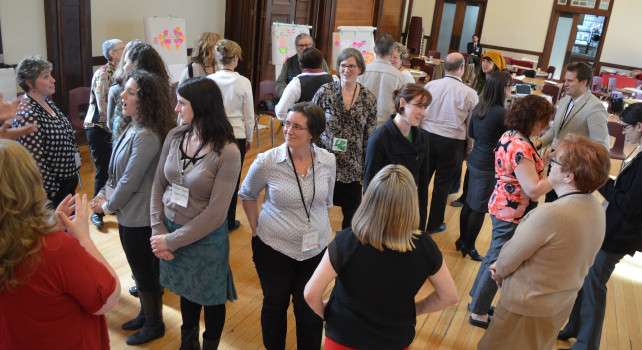
Blog
How nonprofits owning their own space can help communities in Ontario thrive
Recently, I met up with a friend of mine at her pottery studio. She is an emerging ceramics artist, and has a full time job as an engineer. The studio is located inside a local nonprofit that provides affordable studio space and equipment to local artists, organizes exhibitions, sales and networking events, and offers free classes to local communities from time to time. As my friend showed me around her studio, she told me that since it is operated by a nonprofit organization, she is able to access shared studio space at a much cheaper rate than commercial studios, and the networking events and exhibition opportunities have been immensely helpful for her career. She also noted that she feels lucky to have a studio conveniently located in her neighbourhood, giving her more time to work on her art after her full time job.
Just like my friend, many artists need access to affordable, accessible and appropriate space to live, work and share their work. This is just one example of the importance of community spaces owned and operated by nonprofits. These spaces facilitate community development, enhance social interaction and engagement, and generate economic revitalization.
The sports league in your neighbourhood, the affordable child care operated out of your local church or community centre, the orchestra, or other nonprofits in your neighbourhood that provide essential social services and programs like mental health and addictions programs, child care, shelters – they all need space in order to deliver their services.
Unfortunately, these spaces are struggling and slowly disappearing, and nonprofits are being squeezed out of their neighbourhoods. Skyrocketing real estate prices and rapid gentrification have made it increasingly difficult for community organizations to find stable, affordable, accessible and available spaces. Those who currently have access to space are at risk of losing it due to rising rent prices. The lack of nonprofit property ownership and control makes it even more challenging to preserve existing community space.
2023 Data about nonprofits’ access to physical space
ONN’s recent sector-wide survey gathered critical data on nonprofits’ access to physical space, and here’s what the data revealed:
- Nonprofit property ownership is relatively low (27%), with the majority of nonprofits leasing their space (62%), or utilizing city-owned spaces such as libraries and other free public spaces (7%)
- Among those who do own their space, 60% are faith groups, and 35% are community development and housing nonprofits
- Many organizations need space but do not currently have it:
- 20% of B3 (Black-led, Black-serving and Black-focused) organizations and 9% of I4 (Indigenous Benefiting, Indigenous Informed, An Indigenous Partnership, Indigenous led) organizations need space but do not have it
- 10% of grassroots organizations need space but do not have it
“The rent on the pre-pandemic location that we would like to secure has increased significantly and we can’t currently afford it. Current space is not ideal.” -Arts, culture, heritage and tourism nonprofit, Central Ontario
“For some programs/services, we are outgrowing our physical space, but we lack the capacity to start a capital campaign that would help with building expansion.” -Sports, recreation, and other social clubs, Northern Ontario
“Funds to support shared use of spaces would enable groups to collaborate more effectively to meet the needs of the community.” -Social services organization, Central Ontario
What this data tells us is that the majority of nonprofits in Ontario do not own their spaces, and are often dependent on subsidized or discounted rent, or the provision of entirely free operational spaces. Market rate rent is mostly out of reach for nonprofits, and restrictive funding practices that rarely cover operational costs further hinder nonprofits’ abilities to pay rent. In addition, the preservation of existing nonprofit-owned affordable space is also challenging.
For instance, many faith spaces are deteriorating or being demolished, and it is estimated that for every new affordable housing unit built, four existing ones are lost, many of which are managed and owned by nonprofits. Many performing arts organizations are also struggling to maintain their physical spaces with decreased revenues resulting from audiences not returning to pre-pandemic levels.
Nonprofit organizations need stability and predictability to thrive. The lack of affordable community spaces has serious consequences for nonprofits, and the communities they serve. As a sector, we need to think about ways to create more versatile and multi-purpose spaces that can help communities across Ontario thrive.
Social purpose real estate – What it is and why it matters
In October, I had the opportunity to attend the Social Purpose Real Estate Summit in Detroit to learn about how long-term community-owned assets can bolster community resilience. Social purpose real estate (SPRE) is an emerging term referring to the availability, accessibility, and affordability of real estate for mission-driven organizations (nonprofits) and communities. These are buildings and spaces that are owned and operated by mission-driven organizations or community groups for the purpose of community benefit, such as affordable housing, community land trusts, community gardens, nonprofit child care and long term care.
During the conference, I met many colleagues across North America who are doing innovative work around building SPRE. Below are a few examples:
- Mount Dennis Quilt, Toronto: a project by the Learning Enrichment Foundation, designed by community for community, with the first few floors being community space, and affordable housing units above. The neighbouring site will be home to a city run daycare center, offering 99 new childcare spots.
- Lu’ma, British Columbia: Lu’ma develops, owns and manages more than 1,250 affordable housing units across BC. They provide safe and culturally appropriate housing and other support services for Indigenous communities in BC.
My biggest takeaway from the conference is that community ownership is more than just about owning stuff, it is about having a foundation of power, and having a voice. If community organizations own their spaces, then they have the agency to choose whether to stay in a neighbourhood or leave, and they get to decide how to utilize the space in a way that benefits everyone in their community.
Advocating for social purpose real estate
Although nonprofits have the willingness and expertise to own their spaces, limited access to funding, lack of access to land, and barriers to loans and financing all make it challenging, if not impossible for them to advance social purpose real estate.
We need to advocate for the provincial government to:
- Create an inter-ministerial committee to eliminate barriers between government departments to streamline the support of mixed use developments that further various policy objectives.
- Expand and expedite nonprofit access to capital through programs such as the Infrastructure Ontario loans program or other rotating loan funds. This will facilitate the acquisition, preservation, or repurposing of faith buildings and other nonprofit real estate, as well as child care centres, long-term care homes, and deeply affordable housing.
- Make below-market financing available to nonprofits building community infrastructure
- Create a cross-ministerial pooled fund to backstop loan guarantees by municipalities who know their communities’ needs best for nonprofit development.
- Make surplus lands and assets available to nonprofits and nonprofit co-operatives.
- Support Indigenous communities and nonprofit organizations to expand their access to lands for programming, land-based learning, and ceremony.
Without affordable and appropriate community spaces, organizations providing critical services are being pushed out of their neighbourhoods. By owning their own spaces, nonprofits can combat gentrification, prevent community displacement, and utilize space in a meaningful way that can help communities in Ontario to thrive.
SPRE resources
- SPRE 101 Video Series
- Community Bond for your Social Purpose Real Estate Project
- At Jane and Finch, a Fight for Community Space





